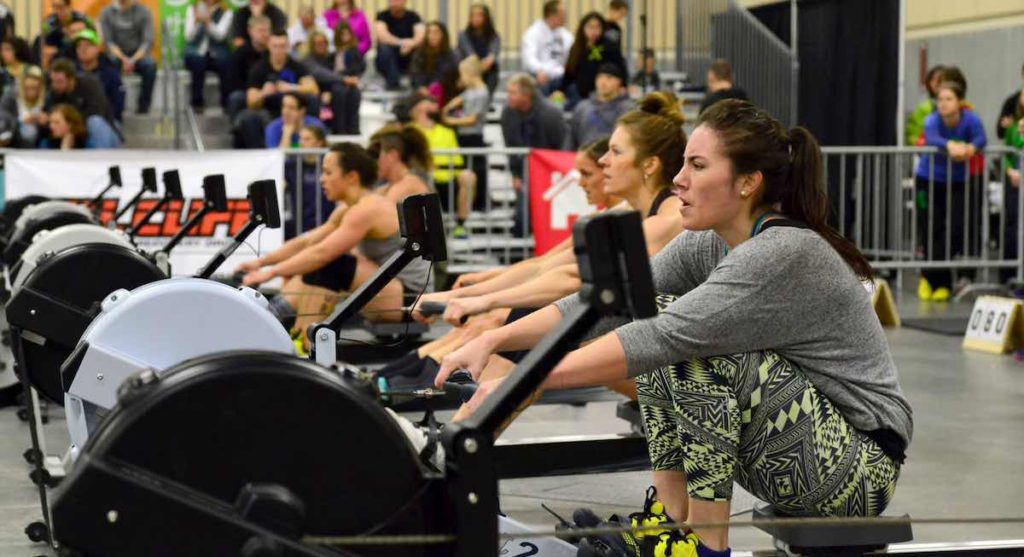The first thing experienced rowers chuckle about when they see people rowing in Globo, CrossFit, or functional fitness gyms is the use of the term “the rowing machine.”
In the rowing world, it’s always referred to as an ergometer, or erg.
Semantics aside, former Canadian national team rowers Krista Guloien-Temple and Nathalie Marbles revealed to us the biggest technical mistakes CrossFit athletes and fitness enthusiasts make on the erg.
1. Holding your Heels Down
In the broader CrossFit community, there seems to be a common misconception that your heels should stay on the footboard throughout the stroke.
“I recently had someone from the CrossFit community reach out to me…Apparently his coach was encouraging him to hold his heels down at the catch,” said Krista Guloien-Temple, a two-time Olympian, who won a silver medal at the 2012 Olympic Games in the women’s eight event.

This is false, she explained. The heels should raise at the catch and then the idea is to drive them down during the stroke.
“The key is to plant your heels for the drive phase. This will be a fast turn around at the catch and something that must be practiced for optimal power through the drive,” Guloien-Temple said.
That being said, if you find your heels raise too much so that you can’t row properly, “you can try lowering your feet, and if that doesn’t work you can sit on a seat pad to give you a bit more height and therefore seat-to-foot ratio,” she added.
2. Cranking the Drag
Another common misconception in the CrossFit community is that cranking the drag to a 10 will somehow make you row faster, Guloien. This is a myth, Guloien-Temple said.
“Rowing at a crazy high drag could cause injury and is rather unnecessary,” she said. “High drag could be best utilized to train explosive power for short distances, (such as) one minute (of rowing).”
One thing to note is that putting the drag at a five on one machine might be equivalent to a six on another machine. It depends on various factors, including whether or not there’s dust in the machine. Thus, to set your drag to a specific number, you must use the drag factor function on the machine’s monitor and take a few strokes until it spits out a number.
When high level rowers do a 2,000 meter test, for example, women’s drag is set to 110 and 130 for men. This might mean a five on one machine and a six on another.

“Testing drag factor for high performance rowers is set based on average weight and set to best mimic the water,” Guloien-Temple explained.
For the purposes of most novice rowers, or CrossFit athletes who are rowing in a multi-modal workout, the safest thing to do is to set your drag somewhere between a four and a six. If you feel you’re not able to generate much power, then increase the drag a little bit, and if it feels too heavy as you pull, then decrease the drag.
3. Too Much Arms
Marbles, who competed at two World Championships, in 2006 and 2008, and the Pan American Games in 2007, said non-experienced rowers tend to use way too much arms.
The first part of the stroke should be all legs, while the arms are straight and suspended from the handle. Some CrossFit athletes tend to bend their arms too early, when in reality the arms simply finish the stroke. In fact, you shouldn’t begin pulling with the arms until your legs are basically straight and your back has begun opening up to finish the stroke.
4. Poor Pacing
Another mistake that hurts performance is, of course, going out too hard, or “flying and dying” as rowers call it. This is all too common for inexperienced rowers, who effectively do the equivalent of sprinting the first 100 meters of a 1 mile run on the erg.
In rowing it all comes down to consistency, Marbles explained. This means each stroke in a 500 meter row, or a 1 km row, or a 5 km row, should be pretty much the same. Though it takes time to learn how to string strokes with consistent power together, it’s worth spending time figuring out a pace you can hold consistently over various distances.
5. Over Gripping
Guloien has also noticed novice rowers often take a death grip on the handle. She recommends relaxing your hands and wrists with a slightly looser grip.
“Wrists should be flat and the handle should sit in the fingers, almost as if you’re making a hook with your hand,” she said.
Featured image: @trueessencephotos